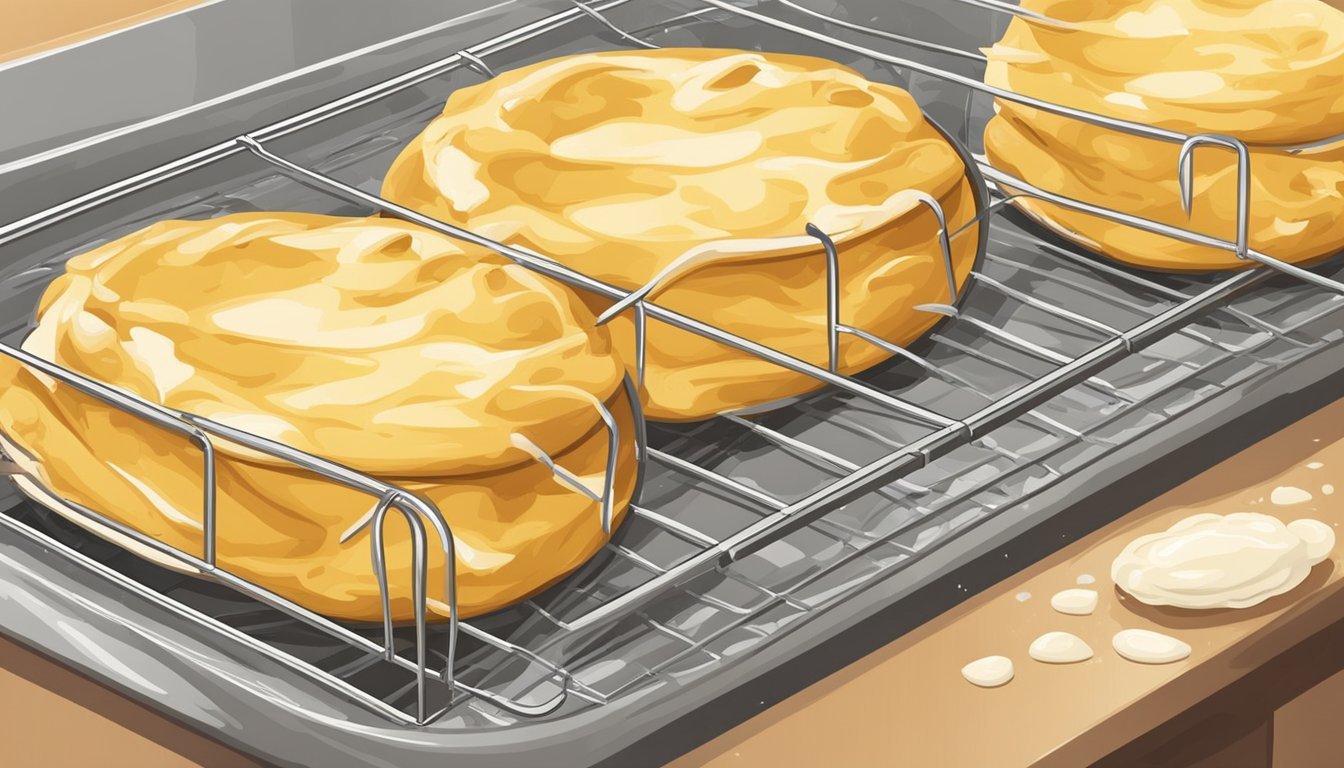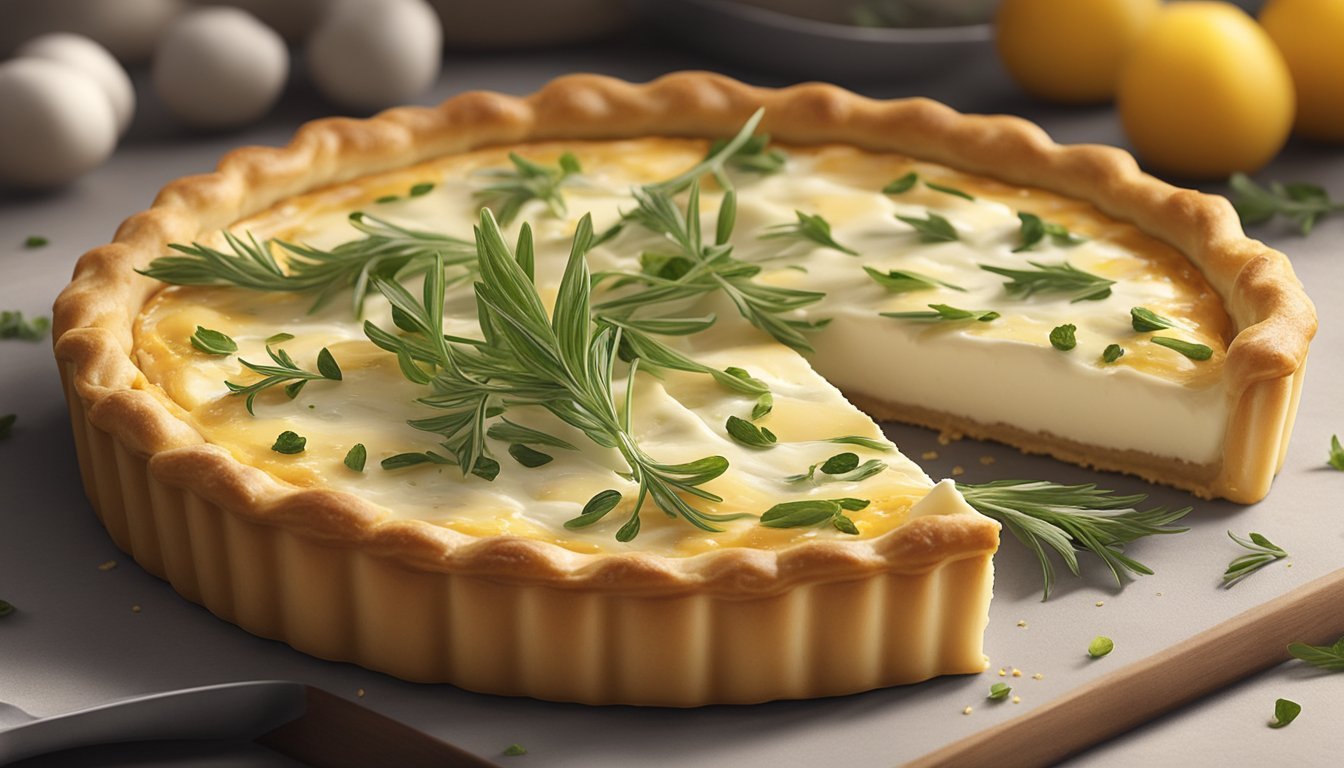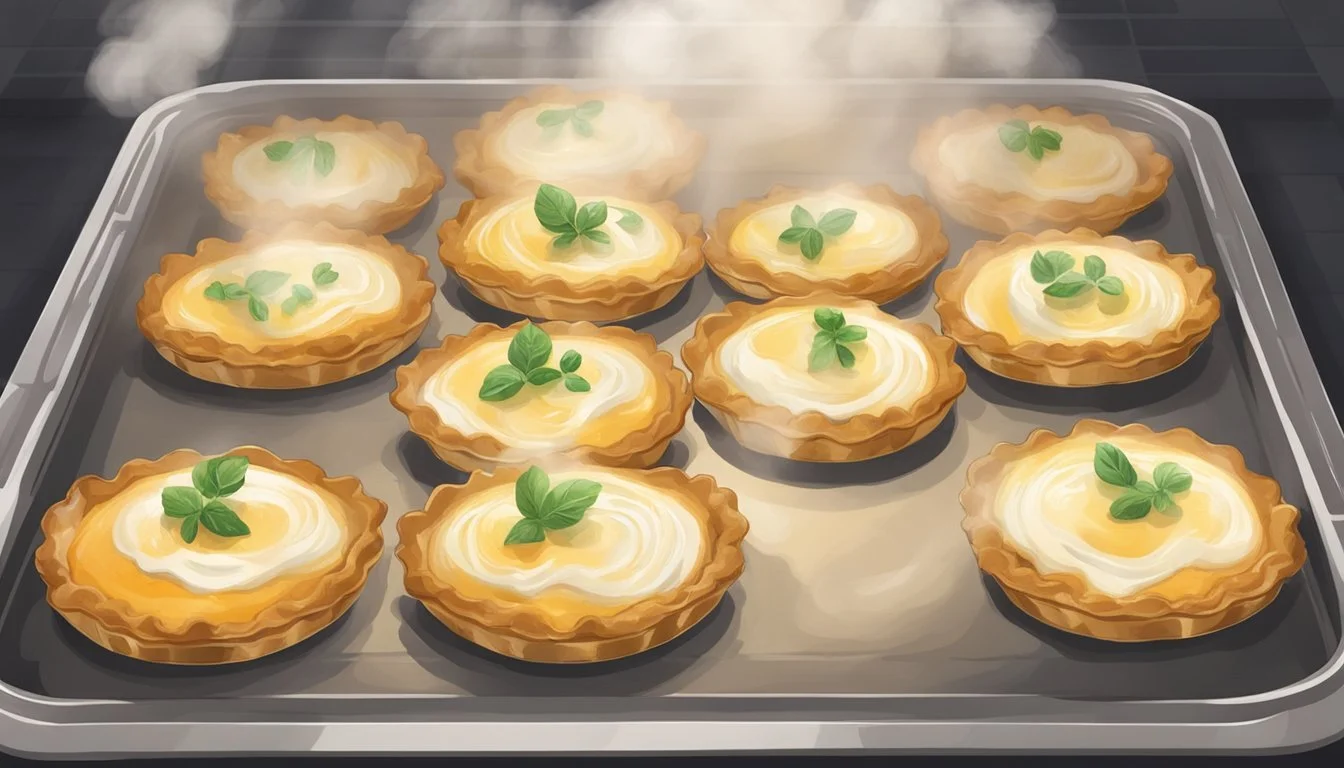Best Way to Reheat Goat Cheese Tart
Ensuring a Flaky Crust Every Time
A goat cheese tart, with its sumptuous filling and flaky crust, is a delightful dish that can be enjoyed both fresh and reheated. However, the key to preserving its textural integrity and flavor lies in the reheating technique. Unlike other dishes that may forgive a quick stint in the microwave, a pastry-based item like a goat cheese (What wine goes well with cheese?) tart demands careful attention to regain its original crispness without drying out.
One must consider the delicate balance between temperature and time when reheating a goat cheese tart. Using methods that distribute heat evenly and gently can make the difference between a soggy or burnt crust and one that maintains its flaky, golden-brown perfection. Techniques such as using an oven may ensure the tart is heated throughout, ensuring that the crust remains as inviting as when it was first baked, while the goat cheese filling becomes warm and soft without reaching the point of overcooking.
Understanding the Basics of a Goat Cheese Tart
Creating a successful goat cheese tart hinges on understanding the ingredients and methods that ensure a deliciously flaky crust and a rich, creamy filling. Choosing the right pan and knowing how to prepare it is also vital to the tart's outcome.
Ingredients Overview
A classic goat cheese tart features a blend of flavorful goat cheese and a smooth, rich cream. The combination of fresh thyme and caramelized onions (What wine goes well with onions?) complements the tangy taste of the goat cheese. Essential to the mix is a light and airy puff pastry or a buttery homemade crust that balances the creamy filling. Ingredients like olive oil and honey can be used to enhance the tart's flavor profile.
Recipe Essentials
The tart base often begins with all-purpose flour, butter, and ice water to create a dough that's processed until just combined. Pie weights are advantageous during blind baking to keep the crust from puffing up. An egg wash applied to the crust can contribute to a golden-brown finish. Meanwhile, the filling calls for smooth goat cheese, heavy cream for richness, and herbs such as thyme to infuse savory notes.
Tart Pan Selection and Preparation
Choosing the correct tart pan is crucial for an easily removable tart with a decorative edge. A fluted tart pan with a removable bottom is ideal. Preparation entails rolling the dough to fit the pan, trimming the excess, and ensuring the sides are uniform. Cooling the dough in the pan before baking and using pie weights over parchment paper will result in a more stable and flaky crust, ready to be filled with the creamy goat cheese mixture.
Pre-Bake Strategies for a Flaky Crust
To ensure a goat cheese tart retains a flaky crust upon reheating, one must utilize effective pre-baking strategies. Proper handling of the dough and preparation techniques are crucial for achieving that desirable buttery texture.
Working with Puff Pastry
When preparing puff pastry for a tart, consistent thickness is key. One should roll out the puff pastry dough to an even thickness, typically about 1/4 inch, ensuring uniform cooking. To prevent the pastry from shrinking, rest it on the baking sheet in the refrigerator for 15-30 minutes before baking. Utilize parchment paper on the baking sheet to avoid sticking, which also makes for an easy release after baking. For enhanced flavor, incorporating unsalted butter when making the dough can lead to a more buttery crust.
Preparation Checklist for Puff Pastry:
Roll even thickness (approximately 1/4 inch)
Rest dough before baking
Use parchment paper on baking sheet
Consider using unsalted butter in dough
Preventing Soggy Bottoms
A "soggy bottom" often occurs when the filling releases moisture into the crust, making it soft and undesirable. To avoid this, one can pre-bake the crust, a process known as "blind baking," which partially cooks the crust before adding the filling. Line the puff pastry with parchment paper and fill with dried beans or lentils to keep the pastry in place and prevent puffing. Bake according to the recipe's instructions, typically at a moderate temperature like 375°F, until the crust is lightly golden and the edges are set. This method eliminates excess moisture, ensuring a flaky pastry upon reheating.
Blind Baking Steps:
Line pastry with parchment paper
Fill with weights such as dried beans or lentils
Bake until golden and set
Optimal Reheating Techniques
To ensure the reheating process retains the tart's delightful texture, one needs to focus on methods that preserve the flaky crust and the delicate balance of flavors.
Oven Reheating for Best Results
Using the oven for reheating goat cheese tart is the recommended approach to maintain its quality. Preheat the oven to 350°F (175°C) to ensure even heat distribution. Place the tart on a baking sheet and cover it loosely with aluminum foil to protect it from direct heat and to prevent the crust from burning.
Steps for Oven Reheating:
Preheat the oven to 350°F (175°C).
Place the tart on a baking sheet.
Cover the tart loosely with foil to retain moisture.
Reheat for about 10-15 minutes, checking periodically.
If necessary, remove the foil in the last few minutes to crisp the crust.
Reheating times may vary depending on the size of the tart and individual oven characteristics. The use of aluminum foil is essential as it helps in keeping the moisture intact, ensuring the filling remains creamy and the crust, flaky.
Avoiding the Microwave for Heating
The microwave should not be used for reheating goat cheese tart. Microwaves work by heating food quickly at a high temperature, which can cause the crust to become soggy and the filling to overcook or become unevenly heated. Furthermore, the quick reheat process does not allow the flavors to properly meld as they reheat, which can diminish the overall quality of the tart.
Reasons to Avoid Microwave Reheating:
Sogginess: The crust can lose its flaky texture and become chewy.
Uneven Heating: The filling may not heat evenly, leading to hot spots.
Texture Loss: The delicate texture of the goat cheese can be compromised.
By following these guidelines, one ensures that the reheated goat cheese tart is nearly as good as when it was freshly baked, with a flaky crust and a perfectly warmed filling.
Executing the Reheating Process
When reheating a goat cheese tart, careful preparation and attention to oven-related details are crucial. These steps ensure that the tart's crust remains flaky and the cheese perfectly melted.
Preparation Steps before Reheating
Preheat the oven to 350°F (175°C). A properly heated oven is essential for a uniformly warm tart.
Puff Pastry Care: If the tart is made with puff pastry, handle it gently to avoid compression that would lead to loss of flakiness.
Instructions for Reheating
Baking Sheet Preparation:
Line a baking sheet with parchment paper.
Place the goat cheese tart on the prepared sheet, which helps in maintaining the bottom crust's texture.
Oven Reheating
Cover the tart loosely with aluminum foil to prevent the top from burning and to keep the moisture levels stable.
Bake in the preheated oven for about 10-15 minutes, or until the tart is heated through and the crust is golden brown.
Final Steps:
Check the tart periodically. Once the cheese is soft and the pastry edges appear golden brown, remove the tart from the oven.
Allow it to rest for a couple of minutes with the lid on to retain heat before serving.
Enhancing the Flavor and Presentation
When reheating a goat cheese tart, one should not only focus on temperature but also on how to enrich the dish's flavor and aesthetic appeal upon serving.
Serving Suggestions
For an optimal tasting experience, the reheated tart should be served warm to accentuate the tart's creamy texture and vibrant flavors. The incorporation of fresh herbs such as rosemary or basil can infuse the dish with aromatic undertones. To further heighten the flavors, a light drizzle of balsamic glaze can add a tangy sweetness that complements the tart's savory profile. Additionally, a sprinkle of sea salt and freshly ground black pepper can be used to taste, enhancing the overall seasoning.
Garnishing and Toppings
Garnishes are not only a final touch for presentation but also integral to the sensory experience of the tart.
Garlic and Shallot: Ensure that any garlic or shallot used in the original recipe maintains its presence, as they are key flavor components. One can also lightly sauté additional garlic for a more pronounced flavor.
Herbs and Vegetables: Fresh herbs like basil should be scattered on top, while a rosemary sprig can serve as an aromatic garnish.
Balsamic Vinegar and Glaze: A drizzle of balsamic vinegar or glaze right before serving adds a bright contrast.
Cheese: Shavings of parmesan cheese impart a salty, umami-rich counterpoint to the tangy goat cheese.
Toppings: Add a few toppings such as pinenuts or walnuts for an added texture.
By thoughtfully reheating and garnishing a goat cheese tart, one can elevate the dish to a new level of culinary enjoyment.
Storing and Handling Leftovers
Proper storage methods ensure a goat cheese tart retains its flavor and flaky texture. Quick refrigeration of any leftovers is crucial to maintain quality.
Proper Storage for Freshness
Leftovers should be stored in an airtight container and placed in the refrigerator to keep them fresh. If the tart was originally served warm, allow it to cool to room temperature before refrigerating to prevent condensation from making the crust soggy. Ideally, a goat cheese tart should be consumed within 2-3 days when stored in the fridge.
Refrigerator Tips:
Cooling Time: 2 hours maximum at room temperature
Temperature: Below 40°F (4°C)
Duration: Consume within 2-3 days
Freezing and Thawing Advice
Although freezing a goat cheese tart may slightly alter its texture, it is a viable option for longer storage. Wrap the tart tightly in plastic wrap followed by a layer of aluminum foil to protect against freezer burn. To thaw, one should move the frozen tart to the refrigerator 24 hours before it is needed, which ensures a gradual defrost and helps maintain the integrity of the crust. Refrain from thawing at room temperature which can lead to an uneven texture.
Freezing Instructions:
Wrap: Plastic wrap + Aluminum foil
Duration: Up to 1 month
Thawing Instructions:
Location: Refrigerator
Time: 24 hours before consumption
Complementary Dishes and Pairings
When serving a goat cheese tart, choosing the right accompaniments can elevate this savory dish to new heights. It's important to consider textures and flavor harmonies to create a satisfying culinary experience.
Accompaniments that Enhance the Tart
Bruschetta: A classic appetizer like bruschetta, with ripe tomatoes and a touch of garlic on crisp slices of bread, offers a refreshing contrast to the rich and creamy goat cheese.
Green Salad: Serving a simple green salad dressed with a zesty vinaigrette brings balance, adding brightness and injecting the meal with vitamin C.
Soup: A smooth soup can be a warm and comforting starter. Consider a tomato tart soup that complements without overpowering the subtleties of the caramelized onion and goat cheese tart.
Savories:
Tomato-based sides: The acidity and sweetness of tomato-based dishes can counterbalance the savory depth of a tart containing caramelized onions and creamy goat cheese.
Rice or grain salads: These options add a pleasant texture and can act as a neutral base, allowing the flavors of the tart to stand out.
Event-Specific Pairing Ideas
Casual Gatherings: For a casual event, one may pair the tart with a selection of appetizers such as stuffed olives or mini kebabs that guests can effortlessly enjoy.
Formal Dinners:
Main Dish: If the tart is being served as a starter in a multi-course meal, follow it with a main dish that is light and does not compete with the heavy cream and richness of the tart, perhaps a poached fish or grilled chicken breast.
Nutritional information can also be considered when creating pairings. A tart rich in creamy goat cheese might be balanced with sides that are lighter and provide nutritional counterpoints, such as dishes high in fiber or antioxidants.
FAQs and Troubleshooting
When reheating a goat cheese tart, achieving a balance between a warmed filling and a flaky crust, without overcooking, is crucial. This section addresses common concerns and explores substitutions that can affect the reheating process.
Common Reheating Concerns
When reheating leftovers, particularly a goats cheese tart, a few frequent questions arise. The main objective is to preserve the tart's savory flavor and flaky crust.
How can I reheat the tart without drying it out?
Method: Preheat the oven to 350°F (180°C). Warm the tart on a baking sheet for about 10-15 minutes.
Tip: Cover the tart with aluminum foil to prevent the crust from burning and the cheese from drying out.
Can I reheat in a microwave?
Answer: It's not recommended. Microwaves can make the crust soggy. If necessary, use low power and short bursts, but the oven is best for a flaky crust.
How do I know when the tart is warmed through?
Check: The tart should feel hot to the touch in the center. Use a food thermometer to ensure the internal temperature is around 165°F (74°C).
Substitutions and Variations
Substitutions in the tart's ingredients require different considerations during reheating to maintain the integrity of the dish.
Olive Oil Replacement: If substituting butter for olive oil, ensure that the crust does not brown too quickly when reheating.
Cream Choices: Swapping out full cream for half-and-half can alter reheating times, as it may curdle if overheated.
Varying Onions: Using sweeter onions like Vidalia instead of yellow onions in caramelized onions might result in a filling that requires careful heating to prevent additional caramelization or burning.
Tomatoes and Herbs: Cherry tomatoes and dried thyme are robust and can withstand the reheating process well. Roasting tomatoes ahead of adding them may also impact reheating time due to their moisture content.
Crumbling Goat Cheese: The texture of crumbled goat cheese can change if reheated for too long, so it's important to keep reheating time to a minimum.
Each ingredient's unique properties can modify the reheating method needed for a quick and easy dinner on busy weeknights or a comfortably warm vegetarian dish. Ensure that any substitutions still lead to a well-warmed tart that upholds its savory flavor and flaky crust.
Conclusion
In reheating a goat cheese tart, the goal is to revive its textures and flavors as if freshly baked. A methodical approach preserves the crust's flakiness and the filling's creamy consistency.
Recap of Key Takeaways
Optimal Temperature: Reheat the tart in an oven preheated to 350°F (175°C). This temperature is sufficient to warm through without burning.
Crust Protection: Covering the crust's edges with aluminum foil prevents over-browning, ensuring a flaky edge.
Heating Duration: It typically takes 10-15 minutes to reheat, but one should keep an eye on the tart to prevent any texture loss.
Moisture Retention: To keep the filling moist, one can add a small amount of cream before reheating.
Avoiding Sogginess: A preheated baking sheet helps maintain a crispy bottom by providing immediate heat when the tart is placed in the oven.
Adherence to these steps guarantees that the reheated goat cheese tart offers a delectable experience akin to its initial serving.









